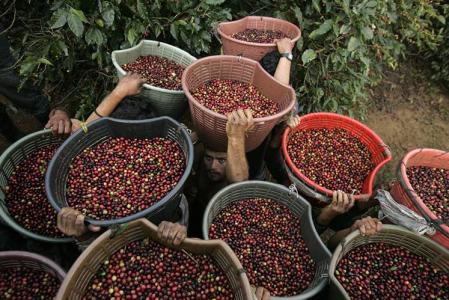A brief introduction to the planting environment in Shaqiso producing area of Ethiopia in the field of fine coffee
A brief introduction to the planting environment in Shaqiso producing area of Ethiopia in the field of fine coffee
Shakisso is located in the southern part of Guji and Oromia, adjacent to Sidama and Gedeo. There are many pits in this area, which were used to mine gold in the early days, so there are many potholes in this coffee growing area. This makes people dangerous when walking between coffee growing areas. Shakiso is a unique producing area of Guji / Cedamory, even in Cedamori, which is a remote area away from most coffee producing areas, and another famous local product is gold. Miners, land, race and other factors also caused unrest in the region in 2006. As a result, the biggest problem facing the region now is that ─ needs manpower to maintain the growing area and harvest coffee. Local small farmers began to grow organic coffee in 2001 and work closely with medium-sized coffee producers because they know how to grow forest coffee in the highlands.
Sidamo has clear acidity, smooth taste and delicate floral smell. The coffee in Sidamo has a variety of flavors. Different soil types, microclimates and countless native coffee species, towering mountains, highlands, plateaus, valleys and plains, diverse topography, and the geology of the area belongs to nutrient-rich, well-drained volcanic soil. the depth of the soil is nearly two meters, and the surface soil is dark brown or brown. The biggest advantage of the area is that the soil fertility is maintained through the circulation of organic matter, using the withered leaves of the surrounding trees or the residual roots of the plants as fertilizer. Therefore, there are obvious differences and characteristics in the coffee produced in cities and towns.
[sun Sidamo]: the bean body is smaller than Longberry and yellowish in green. in the sun drying field of Sidamo, the coffee is placed in the hemp net wooden frame, and the workers take turns to stir the coffee manually in the sun. Xidamo is usually marked with G4 exit. Washing Sidamo is mostly exported to G2 because the treatment process is more perfect.
Coffee beans in Ethiopia are graded according to the proportion of defective beans. Indonesian beans are mainly divided into six grades, namely G1~G6. Ethiopia also uses this method, with the highest grades of washed beans G1 and G2, and those of sun-dried beans G1 and G3.
Washing: Grade-1;Grade-2 (G1 > G2)
Sun: Grade-1 and Grade-3~Grade-5 (G1 > G3 > G4 > G5)

Important Notice :
前街咖啡 FrontStreet Coffee has moved to new addredd:
FrontStreet Coffee Address: 315,Donghua East Road,GuangZhou
Tel:020 38364473
- Prev

The Ireta Manor, one of the large coffee farms in Panama.
Ireta Manor, one of the large coffee farms in Panama, has an ideal environment for coffee growth, volcanic ash soil, good moisture and sun balance. Panamanian coffee grows at an altitude of more than 1400 meters, and the low temperature will make the coffee grow longer, which is more conducive to the development of flavor and aroma. The biodiversity here is very precious, almost all the coffee
- Next

Indonesian Sumatra coffee geographical environment brand flavor description taste
Indonesia Sumatra coffee geographical environment brand flavor description taste Mantenin's bitterness will not upset you, but will make you feel more awake; before you encounter real pain, Mantenin is just an ordinary drink with a bitter taste. It's just a refreshing liquid, just a tool to slow you down, it can't feel your grievances, but many people are crazy about it.
Related
- Does Rose Summer choose Blue, Green or Red? Detailed explanation of Rose Summer Coffee plots and Classification in Panamanian Jade Manor
- What is the difference between the origin, producing area, processing plant, cooperative and manor of coffee beans?
- How fine does the espresso powder fit? how to grind the espresso?
- Sca coffee roasting degree color card coffee roasting degree 8 roasting color values what do you mean?
- The practice of lattes: how to make lattes at home
- Introduction to Indonesian Fine Coffee beans-- Java Coffee producing area of Indonesian Arabica Coffee
- How much will the flavor of light and medium roasted rose summer be expressed? What baking level is rose summer suitable for?
- Introduction to the characteristics of washing, sun-drying or wet-planing coffee commonly used in Mantenin, Indonesia
- Price characteristics of Arabica Coffee Bean Starbucks introduction to Manning Coffee Bean Taste producing area Variety Manor
- What is the authentic Yega flavor? What are the flavor characteristics of the really excellent Yejasuffi coffee beans?

